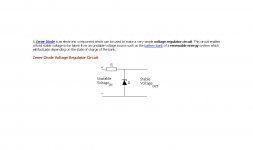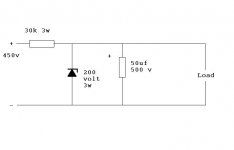Hey All,
Has anyone seen this zener voltage regulator? I haven't received MJ's fourth edition yet and am wondering how much difference there is? It looks a lot like a VR tube circuit? If that's the case may you parallel two zeners to get a higher voltage like a VR? And should you bypass the zener with a cap to make it quieter? And also, of course, does it regulate well?
Has anyone seen this zener voltage regulator? I haven't received MJ's fourth edition yet and am wondering how much difference there is? It looks a lot like a VR tube circuit? If that's the case may you parallel two zeners to get a higher voltage like a VR? And should you bypass the zener with a cap to make it quieter? And also, of course, does it regulate well?
Attachments
Are you joking? The circuit you show is a very, very, VERY common zener application circuit.
To get a higher voltage, choose a different zener or stack many in series.
~Tom
To get a higher voltage, choose a different zener or stack many in series.
~Tom
that is basic!! R limits the current ,, zener keeps the voltage regulated,,make sure the zener is in the right power range(watts),,,thats why you need the resistor to limit the current, so it does not damage the zener and load,,and yes you can add capacitor to output to improve estability...
You get much better performance if you buffer it with an RC filter plus emitter follower(Darlington is best). If you also supply the zener current from a CCS and supply the voltage reference for the CCS from another CCS, then you get quite high performance open loop regulator
The Zener circuit used as a regulator is good for low-fi stuff..
It won't fly for Hi-End audio applications due to the poor tempco of the zener ..
Only useful for loads that are not highly dynamic..
But most important is if you measure the noise floor, it will be a disaster...
Even if you feed the Zener string with a CCS you still add significant noise.... Buffer it with a Darlington to lower the output Z but the noise is still there... The Darlington will have two Vbe to drop through adding even further noise..
Chris
It won't fly for Hi-End audio applications due to the poor tempco of the zener ..
Only useful for loads that are not highly dynamic..
But most important is if you measure the noise floor, it will be a disaster...
Even if you feed the Zener string with a CCS you still add significant noise.... Buffer it with a Darlington to lower the output Z but the noise is still there... The Darlington will have two Vbe to drop through adding even further noise..
Chris
there's no law I know of requiring Hi-End audio circuits to have poor psrr
some attribute audio virtue to "simple" circuits, some "simple" circuits do have poor supply rejection - but how is the product still "simple" with dozen+ components devoted to V regulation?
some attribute audio virtue to "simple" circuits, some "simple" circuits do have poor supply rejection - but how is the product still "simple" with dozen+ components devoted to V regulation?
i have resisted the urge to use complicated circuits with tubes,
even the simplest ones can be very enjoyable......😉
even the simplest ones can be very enjoyable......😉
Being a noob in transistorology (among many faults) how about a highly reliable solution with these requirements for not too critical applications:
- 10-20 volt adjustable
- scalable output (0.01 - 1A?)
- low, non-exotic parts count
- 4 times better s/n than linear regulator
Who calculates a practical Darlington buffer to lower the output Z?
- 10-20 volt adjustable
- scalable output (0.01 - 1A?)
- low, non-exotic parts count
- 4 times better s/n than linear regulator
An externally hosted image should be here but it was not working when we last tested it.
Who calculates a practical Darlington buffer to lower the output Z?
Last edited:
Cerrem, if you use one or more sections of RC filtering before the first transistor base I don't think the noise would be too significant. I don't know any regulator design that doesn't have to contend with voltage reference noise in some way or other.
Hey Guys,
I hadn't seen it. So sue me. I have seen zeners seen as voltage regulators, my audio research is a good example. I want to use it to regulate a low current, 8ma total, G2 supply for some SV83/6P15P's. Tom, I have a pair of your Maida boards but they seem to be overkill in this case.
I hadn't seen it. So sue me. I have seen zeners seen as voltage regulators, my audio research is a good example. I want to use it to regulate a low current, 8ma total, G2 supply for some SV83/6P15P's. Tom, I have a pair of your Maida boards but they seem to be overkill in this case.
I've used VR tubes for quick 'n' dirty pentode screen regulation - worked just dandy. Of course with a hefty PS and Class A operation, we're not exactly talking about wild swings of voltage. A zener should be fine too.
I have some VR150 tubes but they don't work well with such a small current draw. And they aren't in production any more. The attraction of the Zener regulator is the very low parts count, read simplicity. I intend to build it and see how it sounds. I found this online calculator: Zener Diode Voltage Regulator - Electric Circuit Purists! Avert your eyes! With it this is the plan,
Attachments
I would indeed recommending MJ's Valve Amplifiers 4rd edition. He shows that a string of low voltage zeners (5,6V) fed by a CCS (based on cascoded DN2540s) has a noise performance far superior than VR tubes. I recently asked about the use of 5,6V zeners here
http://www.diyaudio.com/forums/tubes-valves/253577-statistical-regulator-va-4rd-edition.html
http://www.diyaudio.com/forums/tubes-valves/253577-statistical-regulator-va-4rd-edition.html
Diodes for TV tuners are better than ordinary zeners: they have a better stability, a lower noise, a lower dynamic resistance and since they are ~33V, you need 5 times less parts compared to 5.6V diodes.
Some example: TAA550, TAA940, TDA1057, CW574, etc
Some example: TAA550, TAA940, TDA1057, CW574, etc
I have some VR150 tubes but they don't work well with such a small current draw. And they aren't in production any more. The attraction of the Zener regulator is the very low parts count, read simplicity. I intend to build it and see how it sounds. I found this online calculator: Zener Diode Voltage Regulator - Electric Circuit Purists! Avert your eyes! With it this is the plan,
That should work just fine. You may want to check for high frequency noise in the output, just in case the capacitor doesn't shunt it all to ground. If you do find noise, you could use a small MLCC or other type of capacitor in parallel with the 50uF one that performs well at high frequencies.
- Status
- Not open for further replies.
- Home
- Amplifiers
- Tubes / Valves
- Zener Voltage Regulator


